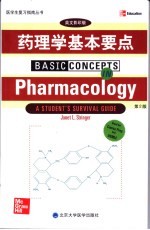图书介绍
药理学基本要点【2025|PDF下载-Epub版本|mobi电子书|kindle百度云盘下载】

- (美)斯特荣格主编 著
- 出版社: 北京:北京大学医学出版社
- ISBN:7810713884
- 出版时间:2002
- 标注页数:285页
- 文件大小:9MB
- 文件页数:304页
- 主题词:
PDF下载
下载说明
药理学基本要点PDF格式电子书版下载
下载的文件为RAR压缩包。需要使用解压软件进行解压得到PDF格式图书。建议使用BT下载工具Free Download Manager进行下载,简称FDM(免费,没有广告,支持多平台)。本站资源全部打包为BT种子。所以需要使用专业的BT下载软件进行下载。如BitComet qBittorrent uTorrent等BT下载工具。迅雷目前由于本站不是热门资源。不推荐使用!后期资源热门了。安装了迅雷也可以迅雷进行下载!
(文件页数 要大于 标注页数,上中下等多册电子书除外)
注意:本站所有压缩包均有解压码: 点击下载压缩包解压工具
图书目录
CHAPTER 1 WHERE TO START1
Part Ⅰ General Principles7
CHAPTER 2 RECEPTOR THEORY7
Agonists7
Efficacy and Potency8
Therapeutic Index9
Antagonists10
Inverse Agonists12
CHAPTER 3 ABSORPTION,DISTRIBUTION,AND CLEARANCE14
First-Pass Effect14
How Drugs Cross Membranes15
Bioavailability17
Total Body Clearance18
CHAPTER 4 PHARMACOKINETICS20
Volume of Distribution20
First-Order Kinetics21
Zero-Order Kinetics24
Steady-State Concentration25
Time Needed to Reach Steady State27
Loading Dose28
CHAPTER 5 DRUG METABOLISM AND RENAL ELIMINATION30
Liver Metabolism30
Renal Excretion31
Part Ⅱ Drugs That Affect the Autonomic Nervous System35
CHAPTER 6 REVIEW OF THE AUTONOMIC NERVOUS SYTEM35
Why Include This Material?35
Relevant Anatomy36
Synthesis,Storage,Release,and Removal of Transmitters39
Receptors40
General Rules of Innervation42
CHAPTER 7 CHOLINERGIC AGONISTS45
Organization of Class45
Direct Cholinergic Agonists47
Cholinesterase Inhibitors48
CHAPTER 8 CHOLINERGIC ANTAGONISTS51
Organization of Class51
Muscarinic Antagonists51
Ganglionic Blockers54
Neuromuscular Blockers54
CHAPTER 9 ADRENERGIC AGONISTS56
Organization of Class56
Direct-Acting Agonists57
Dopamine59
Indirect-Acting Agents59
Cardiovascular Effects of Norepinephrine,Epinephrine,and Isoproterenol60
CHAPTER 10 ADRENERGIC ANTAGONISTS63
Organization of Class63
Central Blockers64
α-Blockers64
β-Blockers65
Mixed α-and β-Blockers68
Part Ⅲ Drugs That Affect the Cardiovascular System71
CHAPTER 11 DRUGS THAT IMPROVE CARDIAC CONTRACTILITY71
Organization of Class71
Cardiac Glycosides71
Sympathomimetics73
CHAPTER 12 ANTIHYPERTENSIVE DRUGS74
Organization of Class74
Diuretics75
Angiotensin-Converting Enzyme(ACE)Inhibitors78
Angiotensin Ⅱ Receptor Antagonists79
Calcium Channel Blockers80
Nitrates81
Other Direct Vasodilators82
α-and β-Blockers83
Clonidine84
Chapter Overview85
CHAPTER 13 DRUGS USED IN HEART FAILURE85
Reduction of Cardiac Workload86
Control of Excessive Fluid86
Enhancement of Contractility86
CHAPTER 14 ANTIARRHYTHMIC DRUGS88
Organization of Class88
Class Ⅰ Drugs(Sodium Channel Blockers)89
Class Ⅱ Drugs(β-Blockers)91
Class Ⅲ Drugs(Potassium Channel Blockers)92
Class Ⅳ Drugs(Calcium Channel Blockers)93
Other Antiarrhythmic Drugs94
Drugs That Increase Heart Rate94
CHAPTER 15 DRUGS THAT AFFECT BLOOD96
Organization of Class96
Antiplatelet Agents98
Anticoagulants99
Thrombolytic Drugs101
Phosphodiesterase Inhibitors102
Drugs Used in the Treament of Anemia103
CHAPTER 16 LIPID-LOWERING DRUGS104
Organization of Class104
Additional Explanation of Mechanisms105
Part Ⅳ Drugs That Act on the Central Nervous System109
CHAPTER 17 ANXIOLYTIC AND HYPNOTIC DRUGS109
Tolerance and Dependence109
Organization of Class110
Barbiturates112
Benzodiazepines113
Buspirone116
CHAPTER 18 ANTIDEPRESSANTS AND LITHIUM117
Organization of Class117
Serotonin-Specific Reuptake Inhibitors(SSRIs)118
Heterocyclics119
Monoamine Oxidase(MAO)Inhibitors120
Other Antidepressants121
Drugs Used in Bipolar Disorder122
CHAPTER 19 ANTIPSYCHOTICS OR NEUROLEPTICS123
Organization of Class123
Typical Antipsychotics125
Serotonin-Dopamine Antagonists126
Neuroleptic Malignant Syndrome127
CHAPTER 20 DRUGS USED IN PARKINSON S DISEASE128
Organization of Class128
Dopamine Replacement Therapy129
Dopamine Agonist Therapy130
Anticholinergic Therapy131
CHAPTER 21 ANTIEPILEPTIC DRUGS132
Organization of Class132
Important Details About the Four Most Important Drugs134
Other Drugs to Consider135
CHAPTER 22 NARCOTICS(OPIATES)137
Organization of Class137
Actions of Morphine and the Other Agonists139
Distinguishing Features of Some Agonists140
Opioid Antagonists141
Opioid Agonist-Antagonists141
CHAPTER 23 GENERAL ANESTHETICS143
Organization of Class143
Uptake and Distribution of Inhalational Anesthetics144
Elimination of Inhalational Anesthetics145
Potency of General Anesthetics146
Specific Gases and Volatile Liquids146
Specific Intravenous Agents147
CHAPTER 24 LOCAL ANESTHETICS148
Organization of Class148
Mechanism of Action149
Special Features About Individual Agents150
CHAPTER 25 INTRODUCTION TO CHEMOTHERAPY153
Approach to the Antimicrobials153
Part Ⅴ Chemotherapeutic Agents153
General Principles of Therapy154
Definitions155
Important Concepts to Understand155
Classification of Antimicrobials158
CHAPTER 26 INHIBITORS OF CELL WALL SYNTHESIS159
General Features159
β-Lactams160
Penicillins161
Cephalosporins163
Carbapenems164
Monobactams(Aztreonam)164
Vacomycin165
Bacitracin165
Polypeptides165
CHAPTER 27 PROTEIN SYNTHESIS INHIBITORS167
General Features167
Aminoglycosides168
Tetracyclines170
Macrolides171
Chloramphenicol172
Clindamycin173
Mechanism of Action174
CHAPTER 28 FOLATE ANTAGONISTS174
Selected Features176
CHAPTER 29 QUINOLONES AND URINARY TRACT ANTISEPTICS177
Drugs in This Group177
Quinolones178
Methenamine179
CHAPTER 30 DRUGS USED IN TUBERCULOSIS AND LEPROSY180
Organization of Class180
Isoniazid181
Rifampin182
Pyrazinamide183
Ethambutol183
Dapsone184
CHAPTER 31 ANTIFUNGAL DRUGS185
Organization of Class185
Polyene Antifungals186
Azole Antifungals187
Terbinafine and Griseofulvin189
CHAPTER 32 ANTHELMINTIC DRUGS190
Organization of Class190
Drugs Used Against Cestodes and Trematodes191
Drugs Used Against Nematodes191
Drugs Used Against Filaria192
CHAPTER 33 ANTIVIRAL DRUGS193
Organization of Class193
Anti-HIV Drugs194
Drugs Used in Influenza195
Other Antivirals196
CHAPTER 34 ANTIPROTOZOAL DRUGS197
Organization of Class197
Selected Features198
Antimalarial Agents198
Therapeutic Considerations199
Special Features200
CHAPTER 35 ANTICANCER DRUGS201
Organization of Class201
Terminology and General Principles of Therapy204
Adverse Effects206
Alkylating Agents208
Antimetabolites209
Antibiotics and Other Natural Products210
Miscellaneous Agents212
Hormonal Agents212
Immunomodulating Agents213
Cellular Growth Factors213
Part Ⅵ Drugs That Affect the Endoerine System217
CHAPTER 36 ADRENOCORTICAL HORMONES217
Organization of Class217
Glucocorticoids220
Mineralocorticoids221
Inhibitors of Adrenocorticoids Synthesis221
CHAPTER 37 SEX STEROIDS222
Organization of Class222
Estrogens224
Antiestrogens225
Progestins226
Antiprogestins226
Oral Contraceptives227
Androgens227
Antiandrogens228
Sildenafil229
CHAPTER 38 THYROID AND ANTITHYROID DRUGS230
Organization of Class230
Thyroid Replacement Therapy231
Drugs That Are Thyroid Downers231
CHAPTER 39 INSULIN,GLUCAGON,AND ORAL HYPOGLYCEMIC DRUGS233
Organization of Class233
Insulins234
Oral Hypoglycemic Agents235
Part Ⅶ Miscellaneous Drugs239
CHAPTER 40 HISTAMINE AND ANTIHISTAMINES239
Organization of Class239
H1 Receptor Antagonists240
CHAPTER 41 RESPIRATORY DRUGS242
Organization of Class242
Methylxanthines243
βAgonists243
Leukotriene Modifiers244
Cholinergic Antagonists244
Cromolyn245
CHAPTER 42 DRUGS THAT AFFECT THE GI TRACT246
Organization of Class246
Drugs That Act in the Upper GI Tract246
Drugs That Act in the Lower GI Tract248
CHAPTER 43 NONNARCOTIC ANALGESICS AND ANTI-INFLAMMATORY DRUGS250
Organization of Class250
Nonsteroidal Anti-inflammatory Drugs(NSAIDs)251
Salicylates,Including Aspirin253
Acetaminophen254
Gold Preparations255
Antigout Agents256
Drugs Used in the Treatment of Headaches257
Cyclosporine and Mycophenolate Mofetil258
CHAPTER 44 IMMUNOSUPPRESSIVES258
Organization of Class258
Cytotoxic Drugs259
Monoclonal Antibodies259
CHAPTER 45 DRUGS USED IN OSTEOPOROSIS260
Organization of Class260
Estrogens261
Calcitonin261
Bisphosphonates261
Selective Estrogen Receptor Modulators(SERMs)262
Other Agents262
CHAPTER 46 TOXICOLOGY AND POISONING263
Principles of Toxicology263
General Principles in the Treatment of Poisoning264
Specific Antidotes265
Index267
热门推荐
- 1155346.html
- 1470221.html
- 847717.html
- 2745810.html
- 2661283.html
- 743880.html
- 3888062.html
- 734082.html
- 2079378.html
- 1308472.html
- http://www.ickdjs.cc/book_2454578.html
- http://www.ickdjs.cc/book_471427.html
- http://www.ickdjs.cc/book_1615844.html
- http://www.ickdjs.cc/book_2033344.html
- http://www.ickdjs.cc/book_547424.html
- http://www.ickdjs.cc/book_2695996.html
- http://www.ickdjs.cc/book_3481605.html
- http://www.ickdjs.cc/book_1960006.html
- http://www.ickdjs.cc/book_2720209.html
- http://www.ickdjs.cc/book_3812119.html